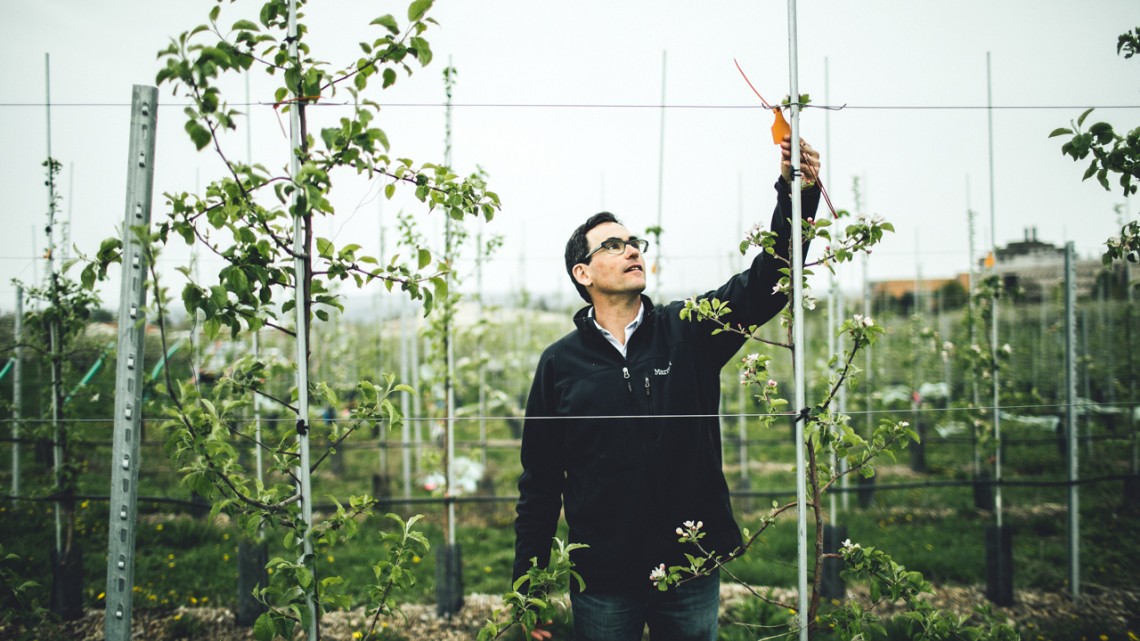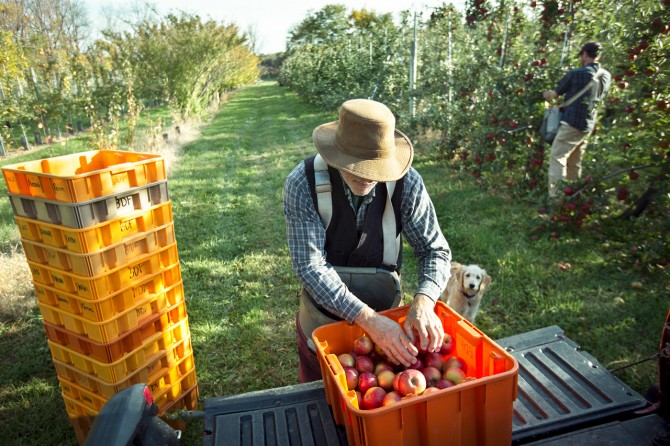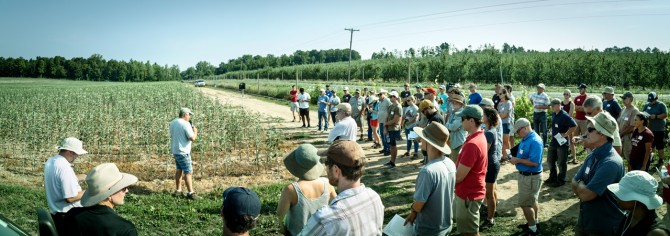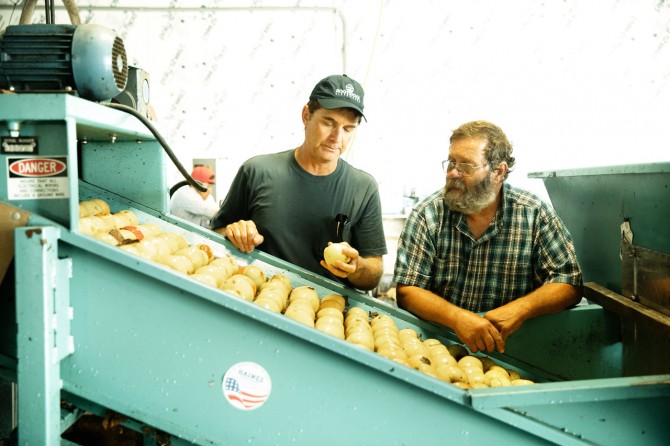
“The industry has been booming because cider producers are innovative.”
– Greg Peck, assistant professor of horticulture
Cornell research boosts New York’s surging hard cider industry
By Jennifer Savran Kelly
Four generations of DeFishers have nurtured apples, pears and cherries on their 450-acre family orchard on the Lake Ontario shore in western New York. For 75 years, apples have been their mainstay.
But in 2012, Dave DeFisher of DeFisher Fruit Farms in Wayne County – the state’s largest apple-producing county, and the fourth largest in the U.S. – took notice of a shift in the apple market: an emerging interest in hard cider. Around the world, consumers were rediscovering a craft beverage combining the flavor depth of wine with the drinkability of beer.
With his son, Luke DeFisher ’13, Dave put their apples to use, fermenting the farm’s first batches of craft cider. Five years later, Rootstock Ciderworks is selling more than 50,000 gallons in more than 10 different hard cider styles and generating vital new sources of revenue.
“A Cornell course on cider-making techniques first got us started,” Dave DeFisher says. Experts in the College of Agriculture and Life Sciences (CALS) helped him launch his brand and provided key technical insights. In recent years, the DeFishers have been aided by Greg Peck, assistant professor of horticulture, who joined CALS in 2015 and has established himself as a global leader in hard cider production and research.
“Greg has supported our own growth and is an invaluable resource answering the tough questions we face. His goal of long-term economic viability for New York state orchards provides big relief for growers who are venturing into new territory,” Dave DeFisher says.
NY well positioned for cider’s comeback
Hard cider was once a favorite drink in North America – from colonial times through Prohibition. To say that hard cider has been making a comeback is an understatement. In the U.S. alone, the hard cider market over the past decade has grown more than 10 times in size, with sales exceeding $1.3 billion in 2017. Taking advantage of this upward trend, Peck has been tapping cider’s full potential to grow New York state’s apple market.
“The industry has been booming because cider producers are innovative,” Peck says. “Consumers want to experience something different in their food and drinks. Cider has a rich depth of flavor and range of products that appeal to a large and growing consumer base.”
Of the more than 800 cider producers in the U.S., nearly 100 are in New York, more than any other state. That growth is no fluke: The state has an excellent climate and soils for growing flavorful cider apples. As consumption has risen, business opportunities have bloomed for the state’s apple growers, cider producers and people in the agritourism industry. But they have lacked the necessary research-based knowledge to adapt to such fast-growing demand, so Peck has been developing field- and lab-based research that will provide much-needed guidance.
At LynOaken Farms, a bustling orchard between Buffalo and Rochester near the Lake Ontario shoreline, cider apple trees were planted in 2004 with the goal of using them for cider production at the farm’s sister winery. But the family farm owners couldn’t find much information on how to grow them.
“Greg wants to see the cider industry advance,” says Chris Oakes, production manager at the family farm, which grows 250 acres of apples in addition to other fruits. “He does research right on our farm and shares his data, allowing us to apply it right away. We’re predicting 15 to 20 percent growth per year in cider apple volume over the next four to five years. We’ve been holding steady at 5 to 10 percent growth, so we’re on the cusp of something big.”
Cornell dedicated to cider’s expansion
Cornell research and outreach is making a difference in orchards across the state. A multidisciplinary team of apple, fermentation and business development specialists in CALS and Cornell Cooperative Extension assist growers and hard cider makers across every element of the production chain. With funding from the New York Apple Research Development Program, Craig Kahlke of the Cornell Cooperative Extension Lake Ontario Fruit Program has been partnering with Peck to study crop load, flower development and harvest maturity of eight hard cider cultivars located at LynOaken Farms.
Peck and Kahlke are members of the Hard Cider Program Work Team, a group of Cornell researchers, instructors, extension educators and industry stakeholders dedicated to expanding the hard cider industry.
Chris Gerling, extension associate in CALS’ Department of Food Science and manager of the Vinification and Brewing Laboratory at Cornell AgriTech, has expanded his work with wine and spirits producers to create educational content for fermented cider producers in New York. In March 2018, agricultural business development and marketing specialist Lindsey Pashow and her colleagues at Harvest NY released the first assessment of New York’s hard cider supply chain and projected growth.
At DeFisher Fruit Farms, Dave and Luke DeFisher are no strangers to growing apples, which account for about half of their crop acreage. But when they decided to move into hard cider production, they faced a steep learning curve.
“Greg has been researching different varieties of hard cider apples and how to grow them in New York,” says Dave DeFisher. “A lot of these varieties have never been grown here, so it was questionable to us: Are they going to work? Will they ripen, or fall off the tree and rot? The fact that he’s done so much work gave us the confidence to try something new.”
Peck continues to experiment. This year, with support from the Cornell University Agricultural Experiment Station in Ithaca, he and his team planted a new one-acre test orchard. Moving some of their research from cooperator farms to campus will allow them to take necessary risks – for instance, developing machines for harvesting cider apples without damaging crops on commercial farms.
Region puts its own stamp on cider business
Cider makers are continually innovating with products that move in bold directions. Melissa Madden ’05 and Garrett Miller, owners of the Finger Lakes Cider House and makers of Kite & String Cider, began with 69 acres of corn, wheat and soy fields they bought in 2008 in Interlaken, New York, in the heart of the Finger Lakes.
As the partners grew their organic Good Life Farm into a sustainable business, they developed a vertically integrated model that incorporates value-added products. Among the ecologically diverse fruits and vegetables produced on the farm, hard cider offered a promising opportunity to craft distinct drinks from ingredients grown in their new orchards.
“Moving to cider worked really well with our plan to have a low-input organic orchard,” says Madden, who in 2013 first started selling hard cider brewed at their farm-based orchard. “It’s still about the agriculture for us: When you use really good fruit and make cider in a high-quality way, it helps people understand agriculture a lot better.”
At their tasting room, they serve locally sourced meals complimented with a robust cider menu. Those ciders – up to 15 ciders from Kite & String, plus a guest cidery from elsewhere in New York – express the unique terroir, or flavor, of the region, says Madden. “Cider has a complex range of sweetness and flavor profiles. We serve ciders that range from a bone dry to exceptionally sweet. You can make varieties to pair with almost any food; there are seemingly infinite possibilities.
“It’s an adventure crafting cider,” she adds. “There’s a really huge opportunity in creating food-friendly drinks made from locally grown ingredients.”
Apples for hard cider may contain up to 10 times more tannins than their culinary counterparts. Tannins, a subset of the naturally produced polyphenols in apples, add to cider’s mouthfeel, creating a more robust and interesting drinking experience. Peck’s lab uses molecular markers to identify the preharvest factors that increase polyphenol development.
“Our research is narrowing down the list of optimal cider apple varieties for New York,” Peck says. “We share what we learn directly with our growers to help them select varieties that will work best for high-quality and flavorful cider.”
Recognizing the value of the research and its economic impact for the state, both public and private entities have contributed funding for hard cider science. The New York State Department of Agriculture and Markets is supporting Cornell research on the role of genetics in producing sought-after flavor qualities and mechanical harvesting, as well as studies on postharvest management for cider apples.
Angry Orchard, based in the Hudson Valley and the largest cider producer in the United States, wants a reliable supply of New York-grown cider apples. The company joined with the New York Farm Viability Institute to fund a two-year research project led by Peck to identify cider apple cultivars and how to manage their maturity to ensure a consistent, high-quality product for cider producers. The project looks to lay the foundation for mechanization in cider apple orchards and will support the establishment of test orchards for future research projects.
Jenn Smith, executive director of the New York Cider Association (NYCA), whose mission includes developing the hard cider market and ensuring industry viability, said the state’s apple growers are in a desirable position thanks to the strong partnership with researchers and extension educators at Cornell.
“While Greg’s horticultural work provides us with essential, sound information, he’s also very collaborative and a synthetic thinker with extraordinary peripheral vision,” Smith says, adding that Peck’s ongoing investment in NYCA-member farms has given growers the confidence to expand into new markets.” Greg is always making connections between various points along the cider supply chain, whether the issues he sees are related to his research or not. He has been a linchpin for our industry.”
Jennifer Savran Kelly is a writer for the College of Agriculture and Life Sciences.
To see more ways Cornell University is helping turn discoveries into real-world solutions for New Yorkers, visit ny.cornell.edu.
Media Contact
Get Cornell news delivered right to your inbox.
Subscribe





